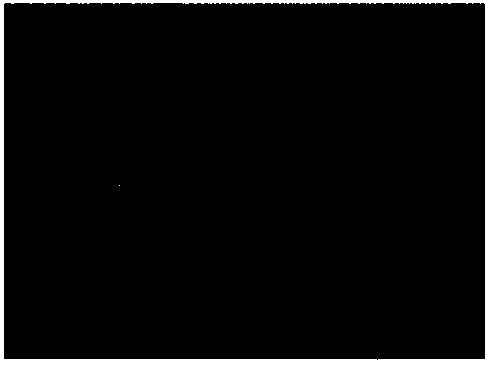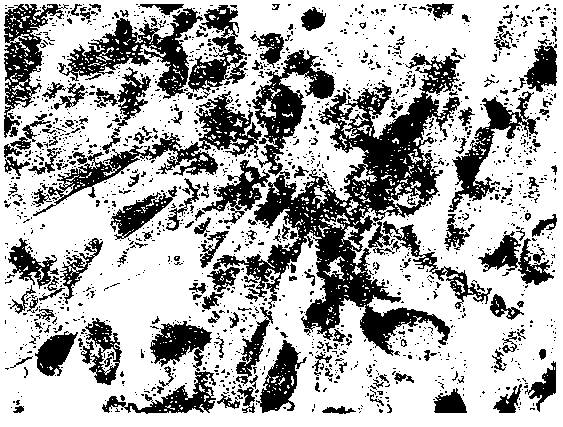Preparation method of placenta source matrix mesenchymal stem cell
A technology derived from mesenchymal stem cells and placenta, applied in the field of culture and isolation of mesenchymal stem cells, can solve the problems of complex placental tissue and undetected, and achieve the effect of simple method and small cell damage
- Summary
- Abstract
- Description
- Claims
- Application Information
AI Technical Summary
Problems solved by technology
Method used
Image
Examples
Embodiment 1
[0026] Example 1 Isolation, culture and cryopreservation of human placenta-derived maternal mesenchymal stem cells
[0027] (1) After washing the placenta repeatedly with phosphate buffered solution (PBS), carefully separate the decidual part of the placenta, then rinse repeatedly with PBS to remove residual blood, and cut it into small pieces smaller than 0.5-1 square centimeters;
[0028] (2) Add 1 times the volume of trypLE according to the total volume of the tissue block TM (Invitrogen, USA) The mixed enzyme solution digested the tissue block at 37°C for 0.3 hours, and stirred with a rotor during the digestion process; then washed and removed the digestive fluid, and then the residual tissue block after the first step was digested, and then 2 times the volume of the tissue block trypLE TM The enzyme solution digested the tissue block at 37°C for 0.5 hours to obtain the digested digestive juice,
[0029] (3) Filter the digestive juice obtained in step (2) with a sieve, s...
Embodiment 2
[0036] Example 2 Expansion and Preparation of Human Placenta-derived Maternal Mesenchymal Stem Cells
[0037] (1) From the qualified primary subculture cell bank obtained in Example 1, a cell containing 3×10 6 Cell cryopreservation tubes, thaw the cells at 37°C;
[0038] (2) Press 2×10 with serum-free medium (LONZA) 4 / cm 2 Inoculate into culture flasks at a density of 37°C, saturated humidity, and 5% CO2 incubator for culture. When the cells reach 80-90% confluence, they are passaged at a ratio of 1:3, and after 3 passages;
[0039] (3) When the confluence of the third passage cells reaches 90%, use trypLE TM Digest the cells, count them, resuspend the cells with the prepared cell protection solution at an appropriate concentration, divide them into sterile containers, seal them, and store them in a suitable environment.
[0040] (4) Take part of the cell resuspension preparation and use the methods well-known to professionals in the field to conduct pathogenic microorgan...
Embodiment 3
[0042] Example 3 Adipogenic and osteogenic differentiation of human placenta-derived maternal mesenchymal stem cells
[0043] (1) Osteogenic differentiation detection: The 4th passage of placental decidual mesenchymal stem cells were selected, routinely digested and centrifuged to make a single cell suspension, and weighed 2×10 4 Each well was seeded in a 24-well plate, and the osteogenic medium (Hyclone Company) was replaced when the cell confluence reached 70%, and then the medium was changed every 3 days, and the osteogenesis was detected by alizarin red staining after 21 days.
[0044] (2) Detection of adipogenic differentiation: select the 4th passage of placental decidual mesenchymal stem cells, routinely digest and centrifuge to make a single cell suspension, press 2×10 4 Each well was seeded in a 24-well plate, and the adipogenic medium (Hyclone Company) was replaced when the cell fusion reached 70%. Then the medium was changed every 3 days, and oil red O staining was...
PUM
 Login to View More
Login to View More Abstract
Description
Claims
Application Information
 Login to View More
Login to View More - R&D
- Intellectual Property
- Life Sciences
- Materials
- Tech Scout
- Unparalleled Data Quality
- Higher Quality Content
- 60% Fewer Hallucinations
Browse by: Latest US Patents, China's latest patents, Technical Efficacy Thesaurus, Application Domain, Technology Topic, Popular Technical Reports.
© 2025 PatSnap. All rights reserved.Legal|Privacy policy|Modern Slavery Act Transparency Statement|Sitemap|About US| Contact US: help@patsnap.com



